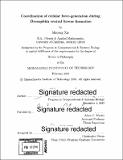| dc.contributor.advisor | Adam C. Martin. | en_US |
| dc.contributor.author | Xie, Shicong, Ph. D. Massachusetts Institute of Technology | en_US |
| dc.contributor.other | Massachusetts Institute of Technology. Computational and Systems Biology Program. | en_US |
| dc.date.accessioned | 2016-06-22T17:54:45Z | |
| dc.date.available | 2016-06-22T17:54:45Z | |
| dc.date.copyright | 2016 | en_US |
| dc.date.issued | 2016 | en_US |
| dc.identifier.uri | http://hdl.handle.net/1721.1/103272 | |
| dc.description | Thesis: Ph. D., Massachusetts Institute of Technology, Computational and Systems Biology Program, 2016. | en_US |
| dc.description | Cataloged from PDF version of thesis. | en_US |
| dc.description | Includes bibliographical references (pages 107-115). | en_US |
| dc.description.abstract | Spatiotemporally coordinated cell behavior is observed during morphogenesis, in both embryonic development as well as tissue regeneration. An open question is how individual cells collectively generate force to achieve the correct tissue architecture. This thesis examines how the apical forces generated by Drosophila ventral furrow cells undergoing collective apical constriction are coordinated to fold the tissue. In Chapter 2, I investigate how discrete actomyosin contraction events are coordinated in time and between neighboring cells to yield tissue contraction and folding. I developed a computational pipeline to identify and classify contraction events from live images of ventral furrow formation. Using this framework, I found heterogeneity in contraction events, both in terms of contraction intensity as well as apical area behavior. I found that apical constricting cells transition in contractile behavior over time, from undergoing reversible contractions into a ratcheted state where contractions are irreversible. High expression of the transcription factor Twist is required for the transition into this irreversible, ratcheted state, which is associated with more neighboring contractions as well as cooperative interactions between neighbors. In Chapter 3, I examined how contractility is buffered against heterogeneity in cell apical area. I found that Cta-signaling is required to robustly maintain apical Factin cortex that can support contracting over larger apical distances. Without this buffering, apically larger cells progressively lose apical F-actin and exhibit delayed initiation of actomyosin contractions, leading to a lack of coordinated constriction. | en_US |
| dc.description.statementofresponsibility | by Shicong Xie. | en_US |
| dc.format.extent | xiv, 115 pages | en_US |
| dc.language.iso | eng | en_US |
| dc.publisher | Massachusetts Institute of Technology | en_US |
| dc.rights | M.I.T. theses are protected by copyright. They may be viewed from this source for any purpose, but reproduction or distribution in any format is prohibited without written permission. See provided URL for inquiries about permission. | en_US |
| dc.rights.uri | http://dspace.mit.edu/handle/1721.1/7582 | en_US |
| dc.subject | Computational and Systems Biology Program. | en_US |
| dc.title | Coordination of cellular force-generation during Drosophila ventral furrow formation | en_US |
| dc.type | Thesis | en_US |
| dc.description.degree | Ph. D. | en_US |
| dc.contributor.department | Massachusetts Institute of Technology. Computational and Systems Biology Program | |
| dc.identifier.oclc | 951809116 | en_US |
